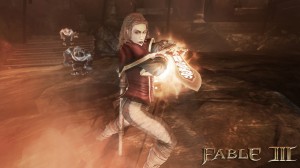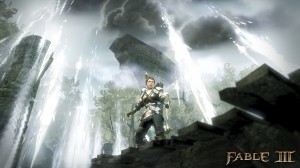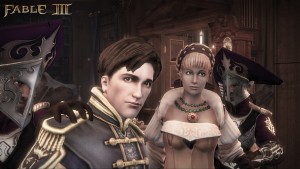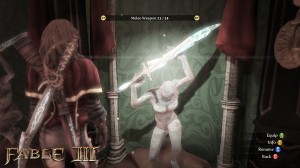A Big Moan About Fable III
- Updated: 6th Aug, 2012
 Fable III really is a mess of a game. On the warning of a friend, I skipped this when it came out in 2010. It was going cheap in some sales not long ago so I picked it up and discovered that yes, my friend was exactly right.
Fable III really is a mess of a game. On the warning of a friend, I skipped this when it came out in 2010. It was going cheap in some sales not long ago so I picked it up and discovered that yes, my friend was exactly right.
On paper, it sounds like a perfectly fine sequel to Fable II. You still have melee and ranged weapons, you still have a variety of magic types and you still have the nice and nasty expressions. As soon as you boot up the game it’s clear that the industrial revolution has fundamentally changed the land of Albion. Buildings are bigger and more imposing. Textures have become darker and more intricately detailed. This game has taken Fable II and forced it, kicking and screaming through the technological wringer.
It shows.
Firstly, the graphical enhancements are simply too much for the Xbox 360 to handle. Numerous times, a panning shot in a cutscene resulting in a choppy blurry mess as the console struggled to keep up. Sometimes an entire battle would pause as the bewildered processors tried to track a dozen hollow men, a plethora of spell effects and a messy dismemberment.
Secondly, whatever design philosophy they were using for this game, Lionhead have managed to drain all the whimsical joy out of things. Take the expressions: In Fable II we could stand in the town square and strike a pose to impress or terrify any and all passers-by.
In Fable III, the only way to access your expressions is in “conversation” and by “conversation” I mean “listening to a boilerplate greeting and then pulling faces at people”. That part isn’t so different to the second game but now, only the person you’re conversing with is affected by your expressions. There’s no way to impress a crowd and this is a shame because there are so many opportunities just crying out for a good comedy fart or chicken dance – like when you’re holding the Royal Court in a chicken outfit.
 Basically, until you unlock more expressions, you can either dance with people or fart on them. Even worse, you can only access one expression per category. In round one of a conversation, you can dance. In round two, maybe you can play pat-a-cake. Hold down your chosen button until the controller buzzes and you’ll get a “bonus” animation with a greater effect.
Basically, until you unlock more expressions, you can either dance with people or fart on them. Even worse, you can only access one expression per category. In round one of a conversation, you can dance. In round two, maybe you can play pat-a-cake. Hold down your chosen button until the controller buzzes and you’ll get a “bonus” animation with a greater effect.
Sure, this is entertaining the first couple of times but by the fifth/tenth/thirtieth time you hoist a giggling townsperson over your head, you’ll be well aware that holding down the A button is not actually a fun game to play. Even when you’ve unlocked more expressions, you’re at the mercy of the Mystery Expression Menu Generator which seems to give you whichever options it damn well pleases, with minor variations based on how much a person likes you. Persuading someone to marry you was never complex but now it’s reduced to a few cycles of holding down the A button, a couple of fetch quests (literally called “Relationship Quest – Fetch”), plus dragging them around by the hand for a bit. Wa-heeey!
The menu has been completely overhauled for this game, and this I heartily endorse. Now, instead of going into a ridiculously complicated set of sub-menus to pick through your inventory you can… not use one at all. Instead, you can only carry one type of food at a time. Stocking up on mutton to heal faster and get fat? Great, but if you want to get drunk you’ll have to throw away all that mutton to buy a beer. Want to give someone flowers or jewellery? Tough luck. You can only give a gift if someone asks for it. What are you, some kind of gift-giving deviant, foisting unwanted presents on an unwilling population? You monster.
 If ever there was a real problem with Fable II, it was the confusing number of potions available. Five different strengths of potion, each rated with a star system… six (SIX!) different actions from potions, plus three special ones…
If ever there was a real problem with Fable II, it was the confusing number of potions available. Five different strengths of potion, each rated with a star system… six (SIX!) different actions from potions, plus three special ones…
Oh, right. That wasn’t a problem at all but in removing the XP system, Lionhead have cut the potions down considerably anyway. Now all you need to worry about is three types of potion: healing, slowing down time and summoning ghostly creatures to help you in battle. How does drinking a potion summon ghostly creatures from beyond? I have no idea.
Potions occupy their own imaginary inventory slots but there’s no way to actually see how many of each you’re carrying. I suppose it doesn’t really matter in Fable III because, as with its predecessor, a few early property investments are enough to destroy the economy and ensure that you can buy all the potions in the world. Literally.
The non-inventory parts of the menu have been replaced by The Sanctuary, a room you can magically enter and leave whenever you like. It’s both rather nifty and terribly annoying, being basically a giant menu that you have to walk around. Mostly, I used it for the map so I could save myself walking around and it’s amazing how quickly I began to resent those two little steps walking from the spawn point to the map table.
 The walk-in closet has clothing options laid out on mannequins but you still use the triggers and bumpers to cycle through different types. Weapons are artfully arranged like museum pieces but you have to walk up to each one individually and, again, use buttons to cycle through. In fact, the only really great part of the Sanctuary is the treasury and that’s because you can amass a giant pile of money, Scrooge McDuck-style. It loses points for not letting you swim around in it.
The walk-in closet has clothing options laid out on mannequins but you still use the triggers and bumpers to cycle through different types. Weapons are artfully arranged like museum pieces but you have to walk up to each one individually and, again, use buttons to cycle through. In fact, the only really great part of the Sanctuary is the treasury and that’s because you can amass a giant pile of money, Scrooge McDuck-style. It loses points for not letting you swim around in it.
In fact, that encapsulates much of Fable III. Things look great on the surface but ultimately disappoint. Sure, the game is still full of character and once you realise that the relationship quests are just grind, the proper quests can be quite admirable. Still, from the demon doors that take ages to open and reward you with dead worlds, to the bizarre timescale once you become ruler of Albion, this game feels like 20 hours of ideas and mechanics. What happened to all the fun?
There’s one memorable quest in which you’re reduced to a tabletop miniature and set to run around an RPG-in-the-making while three wizards argue over the design. With a rather chilling clarity, these gamemasters bicker that no one ever reads item descriptions, discuss how they didn’t have time to properly implement the crafting and railroad dissenting voices into agreeing that fun games are about combat above all else. This sequence is either a desperate cry for help from a keenly self-aware designer or a stunning display of hubristic ignorance.
I honestly can’t tell which.

One Comment